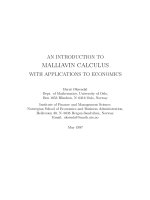- Trang chủ >>
- Đại cương >>
- Kinh tế vĩ mô
economics with calculus
Bạn đang xem bản rút gọn của tài liệu. Xem và tải ngay bản đầy đủ của tài liệu tại đây (5.39 MB, 632 trang )
5523.tp 7/1/04 5:21 PM Page 1
Economics
Calculus
with
5523.tp 7/1/04 5:21 PM Page 2
Economics
Calculus
with
Michael C Lovell
Wesleyan University, USA
World Scientific
W
NEW JERSEY · LONDON · SINGAPORE · BEIJING · SHANGHAI · HONG KONG · TAIPED · CHENNAI
This page intentionally left blank
Library of Congress Cataloging-in-Publication Data
Economics with calculus / Michael C. Lovell.
p. cm.
Includes bibliographical references and index.
ISBN 9812388257 (alk. paper) ISBN 9812388575 (pbk. : alk. paper)
1. Economics, Mathematical. 2. Calculus. I. Title.
HB135 .L68 2004
330.01'515 dc22
2004052464
British Library Cataloguing-in-Publication Data
A catalogue record for this book is available from the British Library.
For photocopying of material in this volume, please pay a copying fee through the Copyright
Clearance Center, Inc., 222 Rosewood Drive, Danvers, MA 01923, USA. In this case permission to
photocopy is not required from the publisher.
All rights reserved. This book, or parts thereof, may not be reproduced in any form or by any means,
electronic or mechanical, including photocopying, recording or any information storage and retrieval
system now known or to be invented, without written permission from the Publisher.
Copyright © 2004 by World Scientific Publishing Co. Pte. Ltd.
Published by
World Scientific Publishing Co. Pte. Ltd.
5 Toh Tuck Link, Singapore 596224
USA office: 27 Warren Street, Suite 401–402, Hackensack, NJ 07601
UK office: 57 Shelton Street, Covent Garden, London WC2H 9HE
Printed in Singapore.
July 20, 2004 14:26 Economics with Calculus bk04-003/chap 0
I dedicate this book to my family
Adrienne Goolkasian Lovell
Leslie and Kenneth Chausse: Nathaniel, Colleen, Laurel
Stacie and Steve Markoski: Michael, Andrew, Alexander
George Lovell and Carrie Cihak
Martin Lovell and Sharon Hunter: Mica
This page intentionally left blank
July 20, 2004 14:26 Economics with Calculus bk04-003/preface
Preface
How should one approach the study of economics? There is no one answer
to this question because the appropriate learning style depends in large
measure upon the reader’s prior training and interests. Those blessed with
a working knowledge of calculus are prepared to absorb the basic analytical
framework of economics by a much easier route than those who lack this
background.
Each year approximately 90,000 high school students achieve a 4 or a
5 score on the Advanced Placement Calculus Examination (AB or BC).
Countless more complete their first year of calculus in college before
enrolling in the introductory economics course. My experience from teach-
ing a calculus-based introductory course is that students blessed with this
background can learn economics more easily and with more enjoyment by
making use of their specialized training. The author of a prominent intro-
ductory economics text has commented that “to mathematically sophisti-
cated students the introductory [textbook] models look na¨ıve and simplistic;
these students are discouraged from going into economics because it is too
simple.”
1
Students with a working knowledge of calculus will find this text
provides an exciting challenge. Far from being dumbed down, this book is
designed to help the reader smarten up.
Some economics textbooks claim they enable the student to learn eco-
nomics without tears. Some even claim they can provide a useful introduc-
tion to economics without either graphs or equations! This book presents
an honest introduction to economics that can be covered in one semester,
not by thinning the soup, but by assuming that the reader has a working
knowledge of the calculus. I strive to make the argument as simple as
1
David Colander, “Telling better stories in introductory macro,” American Economic
Review, May 2000.
vii
July 20, 2004 14:26 Economics with Calculus bk04-003/preface
viii Economics with Calculus
possible, but no simpler. We do not use the calculus to complicate the
analysis but to simplify the presentation.
The standard introductory economics textbook presents economic
theory in translation — it is a translation of concepts developed with
mathematical tools into non-threatening English. In order to avoid talk-
ing calculus to the uninitiated, the standard introductory textbook intro-
duces such basic concepts as “marginal revenue,” “marginal cost,” and
“marginal utility” without telling the reader that they are first derivatives.
The end of chapter problems in the standard textbook are designed for the
numerically challenged. The exercises in this text challenge students to
put their quantitative skills to work. Students with a strong mathematics
background find that it is easier to learn the basic principles of economics
using the calculus rather than reading economics in translation.
Scope
There is a danger in the introductory course that one will try to do too
much. There is the task of allocating scarce time to diverse pedagogical
objectives. The task is complicated, because for many students the in-
troductory course may be the only economics course they will ever take.
Therefore, this book is not just hardcore economics — readers must be
exposed to the breadth of concepts they have to know in order to function
effectively as economic citizens. A student who invests a semester or two
in the study of economics should acquire the background necessary for un-
derstanding articles in the newspaper’s financial section and for segregating
enlightened insight from economic nonsense on the editorial page. Because
many students find that the introductory course turns out to be only the
beginning, one of the responsibilities of the introductory text is to provide
students planning to major in economics with a good overview of the dis-
cipline and an understanding of the types of intellectual demands imposed
upon the student of economics. This text is designed to help continuing
students master the basic analytic tools they will be expected to bring with
them when they enter more advanced courses.
I also hope that this volume will be an interesting independent read for
anyone who majored in science or engineering in college but now wishes to
pursue the study of economics. It should be of interest to anyone with a
quantitative background who wishes to study economics in preparation for
a career shift into the worlds of business or finance. It may also interest
anyone with a quantitative bent who enjoys reading about economics and
July 20, 2004 14:26 Economics with Calculus bk04-003/preface
Preface ix
business developments in the popular press but wants to take a deeper and
more structured look at how economists analyze how the system works.
Mathematical prerequisites
In developing these materials I have given a high priority to not requiring
more mathematics than is covered in the standard high school Advanced
Placement Calculus course (AB or BC). I do not assume that the reader
has studied probability or statistics. Because Lagrangian multipliers are
not covered in AP Calculus, I solve problems of constrained maximization
by substituting the constraint into the objective function, but Lagrangians
are covered in an appendix for any reader who has a stronger mathematical
background than is assumed in this text. Partial differentiation, the one
indispensable calculus topic that is not covered in the standard Calculus
Advanced Placement Course, is carefully and patiently introduced to the
student during the discussion of demand functions in Chapter 3. When
developing models of economic growth I have found that many of my stu-
dents find e
rt
intimidating; therefore, we work in discrete time and write
(1 + r)
t
.
I have found that students who have earned a 4 or a 5 on the Calculus
AP course (AB or BC) do not find the mathematics employed in this text
too much of a stretch.
2
Students with a lower score should consider study-
ing more math before attempting a course based on this text or else take
a conventional introductory economics course. The level of mathematics in
this text may seem pedestrian to upper division students in the sciences
who have a stronger mathematical background than this text presumes. It
is obviously not the type of mathematics that economists use in serious
research these days. But after completing the overview of economics
provided by this text, the mathematically sophisticated reader will have
the economics background required to read more advanced economics texts
focusing on whatever areas of economics may be of particular interest.
Organization
In deciding how to organize the material in this text I have kept several
principles in mind.
2
If their calculus is rusty, they may wish to consult Stephen Silver’s review at
/>July 20, 2004 14:26 Economics with Calculus bk04-003/preface
x Economics with Calculus
• First, I place micro before macro in order that the students will have
a foundation in micro that can be drawn upon in developing macro-
economic concepts.
• Second, I carefully pace the use of mathematical concepts so as to enable
rusty students to gradually recall the details of their calculus course.
Thus, Chapter 2 refreshes the student’s memory of how to use the
calculus to solve maximization problems and contains the simplest possi-
ble example of constrained maximization. Once our students have flexed
their calculus muscles on economic problems the pace of the analysis can
accelerate.
• Third, I try to move from the simple to the complex. For example, I
discuss monopoly before competitive markets because it is easier. Again,
I do not begin the discussion of macroeconomics with growth theory,
however logical that might be, because students find it easier to start
worrying about fiscal and monetary policy issues before moving on to
the complexities of growth theory in Chapter 12.
• Fourth, I decided not to segregate international trade topics to a chapter
near the end of the book. This decision was motivated in part by my
fear that this chapter might be skipped over at the end of semester rush.
But the primary reason is that international trade permeates practically
every aspect of economics and provides wonderful examples for illustrat-
ing the applicability of economic theory to important policy issues. So
the theory of comparative advantage is discussed when the production
transformation curve is introduced in Chapter 2. In Chapter 3 on supply
and demand the student is introduced to the topics of foreign exchange
rates, tariffs and quotas. In almost every chapter, the student encounters
trade issues.
There is room for flexibility for those who would prefer to sequence
the topics in a different order. For example, one can start the study of
macroeconomics with Chapter 12 on growth and then drop back, perhaps
selectively, to read about economic indicators and monetary and fiscal
policy.
Classroom alternatives — pick and choose
This book obviously presents more material than most instructors will want
to use, particularly in a one semester course covering both micro and macro-
economics. Some parts are essential. Other sections may be judiciously
July 20, 2004 14:26 Economics with Calculus bk04-003/preface
Preface xi
sampled in accordance with the interests of the students and the objectives
of the instructor. Here are some alternative strategies for using this book
in the classroom:
1. I have found it possible to cover in one semester most but not all the
material in this book with a group of highly motivated students with
strong mathematical skills but no prior coursework in economics. I have
supplemented the text with a paperback book of real-world readings
from the financial press, newspapers and popular magazines.
3
An in-
structor teaching such a course will probably want to make a point of
covering the following barebones core sections of the text plus other sec-
tions that would be of particular interest in the light of current economic
developments or special concerns of the students.
The Micro Core: Ch 1, Ch 2, Ch 3.1–3.6, Ch 4.1–4.3.1, Ch 5.1, 5.2, 5.4,
5.5.1, 5.5.2, 5.6, Ch 6.1–6.3, 6.6, Ch 7.1–7.2.1.
The Macro Core: Ch 1.5.1–1.5.4, Ch 8, Ch 9.1–9.3, 9.5, Ch 10.1–10.4,
and Ch 12.1, 12.4, 12.5.1–12.5.4.
2. In a yearlong micro-macro principles sequence there is ample time to
cover the Micro and Macro Cores plus Ch 10.5 (aggregate demand
and supply), Ch 10.6 (Monetarists versus the Keynesians), Ch 11
(expectations, uncertainty and inflation), Ch 12.2 (Malthusian popula-
tion dynamics), Ch 12.3 (classical growth), Ch 12.4 (growth accounting),
Ch 12.6 (population trends), Ch l2.7 (exhaustible resources) and Ch l2.8
(over fishing).
For greater depth in a two-semester first course, this text may be read
alongside a conventional introductory economics textbook. Read the
conventional text for institutional details, but turn to this book whenever
the text starts to develop the theory. Alternatively, one can progress
chapter by chapter through this text, but look for real world applications
on the internet or in the Economic Report of the President,theNew
York Times,theWall Street Journal, The Economist, or an appropriate
compendium of supplemental readings.
3
Economic: Annual Editions, ed: Don Cole, McGraw Hill-Dushkin. The web now
provides a wonderful source for current event materials. This approach is articulated
by Professors Shyamala Raman at Saint Joseph College, Jean Shackelford at Bucknell
University and Kim Sosin at the University of Nebraska Omaha in their “just-in-time
syllabus” home page at />July 20, 2004 14:26 Economics with Calculus bk04-003/preface
xii Economics with Calculus
3. I have used the book as a supplement to a traditional non-calculus (delta)
intermediate microeconomics text, assigning Chapters 1 through 7 plus
Chapter 11.2 on market dynamics and speculation, 11.4 on rational
expectations, 12.7 on exhaustible resources and 12.8 on over-fishing.
4. Students enrolled in a standard intermediate macro course may supple-
ment their readings in a conventional nonmathematical text with Ch
1.5.1–1.5.4, Ch 8–10, Ch 11.3–11.5 and Ch 12.1–12.6.
Controversy
Economics is controversy, among professional economists no less than in
Washington and in the financial press. There is no shortage of controversy
in microeconomics. Thus MIT economist Franklin M. Fisher served as
the key witness for the prosecution at the Microsoft antitrust trial while
his MIT colleague Richard Schmalensee was the chief economist for the
defense. The disagreement among macroeconomists is extreme, having at
times reached the point where the discipline was all too accurately described
as being in a state of chaos. At the 1997 American Economic Association
convention, several prominent macroeconomists responded to the question
of whether there was a common core to their discipline. Most thought there
was a core to macroeconomics, but they could not agree on what it was.
One participant at the session commented that there is a core of practical
macroeconomics, but went on to say “This believable core model falls well
short of perfection, leaves many questions unanswered and is subject to
substantial stochastic errors.”
4
It is likely that any macroeconomics text
will be judged to be in serious error by at least 2/3rds of the profession.
There is a temptation in the textbook, no less than in the classroom,
to present economics as revealed truth. Or we may confuse our students
by laboriously partitioning the discipline into “classical,” “neo-classical,”
“new-classical,” “monetarist,” “post-Keynesian,” and “neo-Keynesian”
schools of thought. This text discusses how macroeconomic thought evolved
in reaction to unanticipated historical developments. I present the multi-
plier, the IS-LM apparatus, and short-run and long-run aggregate demand
and supply functions. I develop the concept of rational expectations, the
Lucas supply function, a modified Solow growth model subject to dimin-
ishing returns to scale, and real business cycle theory.
4
Alan S. Blinder, “Is there a core of practical macroeconomics that we should all be-
lieve?” American Economic Review, May 1997.
November 29, 2005 16:35 Economics with Calculus bk04-003/preface
Preface xiii
Exercises
The exercises at the end of the chapters are designed to help readers test and
strengthen their understanding of analytical materials. Symbols distinguish
two types of questions:
* Indicates questions that elaborate on the analysis of the text, often by
considering different applications of the techniques or asking the students
to work with slightly more complicated problems. Sometimes they in-
volve extensive independent projects, such as the question at the end of
Chapter 1.
# Distinguishes questions that are more demanding mathematically than
the material in the text.
Counter Culture
This is not a traditional introductory economics text. It is a slim volume
and does not claim to cover all the material in traditional introductory
textbooks, which often run to more than 1,000 pages and weigh in at over
4 1/2 pounds. It does not come with a CD Rom presenting videos of the
author. It’s produced in black and white rather than gaudy color. It’s just
abook.
Supplements, Updates and Feedback
For supplements and updates, readers should check on the text’s
web site: />comments, suggestions and complaints are invited to email the author at
, Subject: EconCalc.
Acknowledgements
My first debt is to Professors Burton C. Hallowell, Gerald M. Meier and
Robert A. Rosenbaum for inviting me, ages ago, to moonlight at Wesleyan
University in order to teach a special introductory economics course for
students with a working knowledge of calculus. My department chair at
Yale approved this assignment reluctantly, pointing out that this would not
be a career-building activity. He was obviously right, but teaching intro-
ductory economics to calculus-aware students was so much fun! So it was
with great excitement, several years later, that I resigned my professorship
at Carnegie-Mellon University to accept an invitation to become a full-time
November 29, 2005 16:35 Economics with Calculus bk04-003/preface
xiv Economics with Calculus
member of the Wesleyan faculty. My colleague Tom Whitin and I shared
responsibility for teaching this special introductory course for many years.
This book grew out of the course that I initially taught as a moonlighter.
The book has benefited from the helpful suggestions of many friendly
critics. I owe much to the critical comments of Dr. Andr´as Simonovits
of the Hungarian Academy of Science, Professor Matthew J. Baker of the
United States Naval Academy, Professor Lawrence Klein of the Univer-
sity of Pennsylvania, and Professor Stephen J. Silver of the Citadel. I am
indebted to all my students, but particularly to Yu-hsin Chang, Adriel
Gerard, Benjamin Landis, Ehimika Ohiorhenuan, Gergory Ramkhelawan,
Sherida Powell, Eli Staub, Mark Umbarger, and Shenyi Wu for the
thoughtful feedback and careful suggestions that helped to make this book
more student friendly. Professors Timothy A. Park of the University of
Georgia and Roman Weil of the University of Chicago Business School
kindly advised me on technical topics.
This book would not have seen the light of day if it had not been for the
skilled professional team at World Scientific Publishing. I am particularly
indebted to Yubing Zhai and Juliet Lee Ley Chin for their wonderful edito-
rial support and their patience in nursing the book through to completion.
Michael C. Lovell
January 2004
July 20, 2004 14:26 Economics with Calculus bk04-003/
Contents
Preface vii
1 Introduction 1
1.1 Economics defined 1
1.2 The scope of economics 3
1.3 Allocating resources 5
1.4 Adam Smith and the invisible hand of free enterprise 6
1.5 Economic performance: An overview 8
1.6 Prospectus 19
2 Production Possibilities 23
2.1 Overview 23
2.2 The production transformation curve 24
2.3 Opportunity cost and the MRT 27
2.4 Linear programming 34
2.5 The gains from trade 41
2.6 Methodological note 49
Appendix 2.1. Alternative proof of a fundamental proposition 51
3 Supply and Demand: Where do Prices come from? 57
3.1 Overview 58
3.2 The Middletown housing market, a parable 58
3.3 The Econoland corn market 64
3.4 Demand and supply curve shifters 71
3.5 Elasticity 75
3.6 Some applications 85
3.7 Foreign exchange rates 90
3.8 Taxes 97
xv
July 20, 2004 14:26 Economics with Calculus bk04-003/
xvi Contents
3.9 Markets versus the ballot box 111
4 Maximizing Satisfaction 121
4.1 Introduction 122
4.2 One good and two consumers 122
4.3 Two goods and one consumer 134
4.4 Indifference curve applications 151
4.5 The box diagram — Two goods and two consumers 165
Appendix 4.1. Lagrangian Multipliers 175
5 The Business Enterprise: Theory of the Firm 183
5.1 Introduction 183
5.2 Organization of the firm 184
5.3 Profits and accounting 192
5.4 The technological constraint 202
5.5 Maximizing profit 211
5.6 Management science illustrated: OLS & JIT 221
6 Market Structure 235
6.1 Overview 235
6.2 Competitive markets 237
6.3 Monopoly versus competition 253
6.4 Monopolistic competition 266
6.5 Oligopoly 274
6.6 Antitrust action 286
7 Distribution: Who Gets What? 295
7.1 Overview 295
7.2 Measuring inequality 296
7.3 Rewards: Wages, productivity, exploitation and monopsony 309
7.4 Government and the distribution of income 319
8 Monitoring Economic Performance 333
8.1 Overview — Macro versus micro 333
8.2 An economic report card 334
8.3 Unemployment 337
8.4 Inflation arithmetic 353
8.5 How to live with inflation 370
8.6 Business cycles 384
Appendix 8.1. Compound interest 392
July 20, 2004 14:26 Economics with Calculus bk04-003/
Contents xvii
9 GDP Accounting and the Multiplier 399
9.1 Overview 399
9.2 GDP, disposable income and consumption spending 401
9.3 The simple multiplier: Depression economics 414
9.4 A simple model of the business cycle 426
9.5 Critique and qualifications — Shrinking multipliers 430
10 Money, Prices and Output 441
10.1 Overview 441
10.2 Explaining investment and the IS curve 442
10.3 The money supply 450
10.4 Money and interest rates 465
10.5 Aggregate demand — Aggregate supply 479
10.6 Monetarists versus Keynesians 489
11 Dynamics, Expectations and Inflation 497
11.1 Introduction 497
11.2 Market dynamics 498
11.3 Inflation, unemployment and the Phillips curve 516
11.4 Rational expectations 536
11.5 What should central bankers do? 541
Appendix 11.1. Solving first order linear difference equations 549
12 Growth and Development 553
12.1 Introduction 553
12.2 Malthusian population dynamics 555
12.3 A classical growth model, simplified 556
12.4 Growth accounting — The sources of economic growth 559
12.5 A neo-classical model of the growth process 563
12.6 Population trends 573
12.7 Exhaustible resources 578
12.8 Renewable resources — Over-fishing 584
12.9 Conclusions 589
Appendix 1. Further Reading 595
Appendix 2. Web Resources 599
Index 603
This page intentionally left blank
July 20, 2004 14:26 Economics with Calculus bk04-003/chap 1
Introduction
1.1 Economics defined 1
1.2 The scope of economics 3
1.3 Allocating resources 5
1.4 Adam Smith and the invisible hand of free enterprise 6
1.5 Economic performance: An overview 8
1.5.1 Economic growth 8
1.5.2 The transformation of agriculture 11
1.5.3 Unemployment 12
1.5.4 Inflation 15
1.5.5 Foreign exchange rates 16
1.5.6 Inequality 18
1.6 Prospectus 19
Summary 20
Exercises 20
1.1 Economics defined
In a general way, everyone knows what economics is about. All of us par-
ticipate in the market, buying our bread or the daily paper, searching for
a job or relaxing with an inheritance, borrowing for a car or investing in
the stock market. We are all part of a system, a system in which some
fare much better than others. We are all threatened, but some more than
others, by the prospect of unemployment. All of us must worry that in
the years to come inflation will erode the value of our savings. All of us
can hope to benefit from vigorous economic growth and the maintenance
of economic stability. But how should economics be defined?
A modern dictionary
1
defines our subject as follows:
1
The American Heritage Talking Dictionary, 3rd edition, 1994.
1
July 20, 2004 14:26 Economics with Calculus bk04-003/chap 1
2 Economics with Calculus
ec ·o·nom·ics n. Abbr. econ. (used with a sing. verb). The social
science that deals with the production, distribution, and consump-
tion of goods and services and with the theory and management of
economies or economic systems.
Writing more than a century and a half ago, philosopher-economist John
Stuart Mill [1806–1873] presented a quite similar statement in his popular
Principles of Political Economy:
[The] subject is wealth. Writers on Political Economy profess to teach,
or to investigate, the nature of Wealth, and the laws of its production
and distribution: including, directly or remotely, the operation of all the
causes by which the condition of mankind, or of any society of human
beings is made prosperous or the reverse.
Renowned British economist Alfred Marshall [1842–1924] defined eco-
nomics as follows in his Principles of Economics:
2
Economics is a study of mankind in the ordinary business of life; it
examines that part of individual and social action which is most closely
connected with the attainment and with the use of the material requi-
sites of well-being.
In contrast, a modern intermediate microeconomics text explains:
3
Economics is traditionally defined as the study of the allocation of scarce
resources among competing end uses. This definition stresses two im-
portant features of economics. First, productive resources are scarce —
they do not exist in sufficient amounts to satisfy all human wants. This
scarcity imposes a variety of constraints on both the choices available to
a society and the opportunities open to its members. [Second,] choices
must be made about how resources will be used. The necessity to
make choices leads to the second feature of economics: the concern with
how those choices are actually made.
By the time you have finished this book, this last definition may well make
the most sense.
2
Alfred Marshall’s highly successful text, first published in 1890, went through eight
editions.
3
Walter Nicholson, Microeconomic Theory: Basic Principles and Extensions, Dryden,
1995, p 3.
July 20, 2004 14:26 Economics with Calculus bk04-003/chap 1
Introduction 3
1.2 The scope of economics
These definitions do not indicate the full range of issues studied by
economists. For starters, a good way to understand the scope of economics
is to consider the following short list.
• How markets work to determine prices and allocate resources.
• How governments influence, for better or for worse, market outcomes
through tax policy, tariffs, subsidies, patent protection, environmental
policy, etc.
• How a nation’s central bank (e.g., the Federal Reserve System of the
United States) may influence the money supply, interest rates, unem-
ployment, inflation, and the rate of growth of output.
• How we measure income inequality, inflation, unemployment, and pro-
ductivity growth.
This is only a short list. Economic researchers today are interested in a
much longer list of topics.
One might define economics as what economists study and economists
as those who study economics. While such a definition is obviously circular,
something of the flavor of what economics is all about can be obtained by
perusing the titles of working papers reported on Table 1.1.
4
The topics
range from the stock market to monetary policy and from software develop-
ment to smoking cessation. The papers were produced by the distinguished
group of economists associated with the National Bureau of Economic
Research (NBER). Founded in 1920, the NBER is a private, nonprofit,
nonpartisan research organization dedicated to promoting a greater under-
standing of how the economy works. The more than 500 professors of eco-
nomics and business now teaching at universities around the country who
are NBER researchers are leading scholars in their fields. As the list makes
clear, these scholars are putting the research techniques of economists to
work on a wide range of exciting topics.
5
4
A working paper, such as those listed on the table, is a preliminary draft research
report that the author circulate for comment and suggestions before the final version of
the paper is published in an economics journal, often more than a year after the working
paper has been made available to interested scholars.
5
The NBER Website, , contains a complete list of the working
papers produced over the years. Included are abstracts summarizing in a couple of
paragraphs the main points of each paper. More than this, faculty and students at uni-
versities that subscribe to the service may download over the Internet the complete text
of any NBER working paper in PDF format.
July 20, 2004 14:26 Economics with Calculus bk04-003/chap 1
4 Economics with Calculus
Table 1.1. Working papers produced by NBER scholars (week of August 1–7, 1999).
Tradable Deficit Permits: Efficient Implementation of the Stability Pact in the
European Monetary Union, Alessandra Casella #7278
Race and Home Ownership, 1900 to 1990, William J. Collins and Robert A.
Margo #7277
Price Stability as a Target for Monetary Policy: Defining and Maintaining Price
Stability, Lars E.O. Svensson #7276
Size and Growth of Japanese Plants in the United States, Bruce A. Blonigen and
KaSaundra Tomlin #7275
The Effects of Direct Foreign Investment on Local Communities, David N. Figlio and
Bruce A. Blonigen #7274
The Competition between Competition Rules, Hans-Werner Sinn #7273
Liquidity Crises in Emerging Markets: Theory and Policy, Roberto Chang and
Andr´es Velasco #7272
Consumption Over the Life Cycle, Pierre-Olivier Gourinchas and Jonathan A.
Parker #7271 (IFM, EFG)
ABC at Insteel Industries, V.G. Narayanan and Ratna G. Sarkar #7270
An Empirical Characterization of the Dynamic Effects of Changes in Government
Spending and Taxes on Output; Olivier Blanchard and Roberto Perotti #7269
Taxing Retirement Income: Nonqualified Annuities and Distributions from Qualified
Accounts, Jeffrey R. Brown, Olivia S. Mitchell, James M. Poterba, and Mark J.
Warshawsky #7268
No Contagion, Only Interdependence: Measuring Stock Market Co-movements,
Kristin Forbes and Roberto Rigobon #7267
Is Hospital Competition Socially Wasteful? Daniel P. Kessler and Mark B.
McClellan #7266 (HC)
International Institutions for Reducing Global Financial Instability, Kenneth
Rogoff #7265
Trade and Growth: Import-Led or Export-Led? Evidence from Japan and Korea,
Robert Z. Lawrence and David E. Weinstein #7264
Can Capital Mobility be Destabilizing? Qinglai Meng and Andr´es Velasco #7263
Determinants of Smoking Cessation: An Analysis of Young Adult Men and Women,
John A. Tauras and Frank J. Chaloupka #7262
Optimal Monetary Policy Inertia, Michael Woodford #7261
Quality Certification and the Economics of Contract Software Development: A Study
of the Indian Software Industry; Ashish Arora and Jai Asundi #7260
A Tax on Output of the Polluting Industry is not a Tax on Pollution: The Importance
of Hitting the Target; Don Fullerton, Inkee Hong, and Gilbert E. Metcalf #7259
Is There Monopsony in the Labor Market? Evidence from a Natural Experiment
Douglas Staiger, Joanne Spetz, and Ciaran Phibbs #7258
The Band Pass Filter, Lawrence J. Christiano and Terry J. Fitzgerald #7257
Assessing the Impact of Organizational Practices on the Productivity of University
Technology Transfer Offices: An Exploratory Study, Donald Siegel, David Waldman,
and Albert Link #7256
The Japanese Recession of the 1990s: An Exploration of Its Causes, Albert
Ando #7255
July 20, 2004 14:26 Economics with Calculus bk04-003/chap 1
Introduction 5
Table 1.1. (Continued)
Distortionary Taxation, Excessive Price Sensitivity, and Japanese Land Prices,
Kiyohiko G. Nishimura, Fukujyu Yamazaki, Takako Idee, and Toshiaki
Watanabe #7254
Are All Banking Crises Alike? The Japanese Experience in International Comparison,
Michael Hutchison and Kathleen McDill #7253
Tax Policy and Consumer Spending: Evidence from Japanese Fiscal Experiments,
Katsunori Watanabe, Takayuki Watababe, and Tsutomu Watanabe #7252
Determinants of the Japan Premium: Actions Speak Louder than Words, Joe Peek
and Eric S. Rosengren #7251
The Japanese Banking Crisis: Where Did It Come From and How Will It End?,
Takeo Hoshi and Anil Kashyap #7250
Environmental Policy and Firm Behavior: Abatement Investment and Location
Decisions under Uncertainty and Irreversibility; Anastasios Xepapadeas #T0243
1.3 Allocating resources
Although economists investigate a wide range of problems, there is one uni-
fying concern that provides coherence to the investigations of economists.
Economists are concerned with resource allocation. Here is a set of ques-
tions about resource allocation that every society must resolve, one way or
another:
• Who will work at what job?
• What will be produced?
• Who will receive what?
For a colony of ants and for a hive of bees the answers to these ques-
tions are determined genetically — some are born to be workers, some
may be drones, but only one is destined to be the queen. Quite complex
societal relationships can be genetically coded, but programmed species
cannot adapt rapidly to change. In medieval Europe, who tilled the fields,
who shoed the horses, and who was lord of the manor was determined
by what one’s father had done — arrangements based on custom rather
than genetically programmed can breakdown within a generation or two in
response to changing technologies.
Our modern economy is a decentralized system. No central planning
agency makes basic decisions about what to produce, who shall work at
what job, or who will get to consume how much of what goods. In our
decentralized system what happens is the result of millions of individual
decisions. The amazing thing is that this decentralized system somehow
works:
July 20, 2004 14:26 Economics with Calculus bk04-003/chap 1
6 Economics with Calculus
Consider, if you will, the yellow lead pencil, one of the simplest devices
manufactured in our economy today. Yet no one person knows how to
make this simple product. The lumberjack who cuts down the cedar
tree knows his trade well but does not know how to mine the graphite.
The miner does not know the process by which the graphite is mixed
with lead to make sure that the final product is a number 2 1/2 pencil
and not a 4 or a 2. Neither the lumberjack nor the miner knows how to
mix the yellow lacquer used in coloring the pencil or how to make the
eraser that smudges the page when you try to correct a mistake.
Somehow, the market system manages to coordinate the diverse activi-
ties of individual decision-makers in a way that results in a useful product
rather than chaos. Adam Smith provided a first step toward understanding
how this process works more than two centuries ago.
1.4 Adam Smith and the invisible hand of free enterprise
Economics is more than a set of research techniques. It is more than a
set of loosely connected topics. Economists share a common interest in
a controversial proposition eloquently stated in 1776 by Adam Smith, a
Scottish Professor of Moral Philosophy, in An Inquiry into the Nature and
Causes of the Wealth of Nations:
Every individual endeavors to employ his capital so that its product
may be of greatest value. He generally neither intends to promote the
public interest nor knows how much he is promoting it. He intends only
his own security, only his own gain.
While Smith may sound cynical in asserting that the selfish pursuit of
one’s own interest rather than altruism is the prime motivator of economic
behavior, he went on to argue that greed is good:
And he is in this led by an invisible hand to promote an end that is
no part of his intention. By pursuing his own interest he frequently
promotes that of society more effectively than when he really intends
to promote it. It is not from the benevolence of the butcher, the baker
and the candlestick maker that we expect our dinner, but from their
regard to their own advantage.
Adam Smith was clearly articulating two basic principles underlying
economic thinking to this day.








